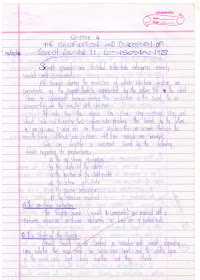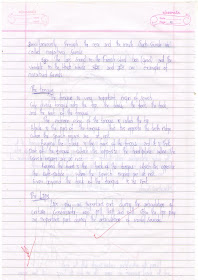Pages
▼
Wednesday, August 11, 2010
Sunday, July 25, 2010
BBC Learning English | Pronunciation Tips
The sounds of English
Learning the sounds
Short vowel / i /
Short vowels
Short vowel / i /
Short vowel / ʊ /
Short vowel / ʌ /
Short vowel /ɒ /
Short vowel /ə /
Short vowel /e /
Short vowel / æ /
Long Vowels
Long vowel /iː/
Long vowel /uː/
Long vowel /ɑː /
Long vowel /ɔː/
Long vowel /ɜː/
Diphthongs (double vowel sounds)
8 Diphthongs
Diphthong / ɪə / near, here, weary
Diphthong /ʊə / poor, jury, cure
Diphthong / aɪ / price, high, try
Diphthong /ɔɪ / choice, boy
Diphthong / əʊ / goat, show, no
Diphthong / eə / square. fair, various
Diphthong / aʊ / mouth, now
Diphthong / eɪ / face, day, break
24 Consonants
[Voiceless consonants]
Voiceless Consonant Sound / p / - pen, copy, happen
Voiceless Consonant Sound /t / - tea, tight, button
Voiceless Consonant Sound / tʃ / -church, match, nature
Voiceless Consonant Sound / k / -key, clock, school
Voiceless Consonant Sound /f / -fat, coffee, rough, photo
Voiceless Consonant Sound / θ / -thing, author, path
Voiceless Consonant Sound / s / -soon, cease, sister
Voiceless Consonant Sound / ʃ / -ship, sure, national
Voiced consonants
Voiced Consonant Sound /d / - day, ladder, odd
Voiced Consonant Sound / dʒ / -judge, age, soldier
Voiced Consonant Sound / g / - get, giggle, ghost
Voiced Consonant Sound /v / -view, heavy, move
Voiced Consonant Sound / ð / -this, other, smooth
Voiced Consonant Sound / z / -zero, music, roses, buzz
Voiced Consonant Sound / ʒ / -pleasure, vision
Other Consonant Sound
Other Consonant Sound /m / -more, hammer, sum
Other Consonant Sound /n / -nice, know, funny, sun
Other Consonant Sound /ŋ / -ring, anger, thanks, sung
Other Consonant Sound / h / -hot, whole, ahead
Other Consonant Sound / l / -light, valley, feel
Other Consonant Sound / r / -right, wrong, sorry, arrange
Other Consonant Sound / w / -wet, one, when, queen
Other Consonant Sound / j / -yet, use, beauty, few
Saturday, July 17, 2010
Tuesday, June 29, 2010
4.2.2 Alveolar
Alveolar Stops
Alveolar stops are formed by the tip and blade of the tongue forming a full closure against the teeth ridge. The sound is produced when the closure is abruptly released so that the air escapes as a puff or air. The alveolar stops occur as a pair, i.e. with a Fortis and Lenis realisation. The fortis stop /t/ is never voiced, and there is generally a devoicing of the lenis sound as well when it is not surrounded by other voiced sounds. Devoicing is therefore most common in the end position of a word. The lenis stop will generally have a marked lengthening effect on the preceding sound(s).

/ t /
as in



/ d /
as in



Thursday, June 24, 2010
Chapter 5 (page -17) The classification and Description of speech sounds II
English Phonetics , Learn English , Learn English Pronunciation ,
English phonetics and phonology
Sunday, June 20, 2010
4.2.1 Bilabial
Bilabial Stops
Bilabial stops are produced by the lower lip forming a closure with the upper lip, so that the air cannot escape. The sound occurs when the closure is abruptly released as a puff of air. The stop sounds occur in a pair, i.e. one Fortis and one Lenis realisation. The Fortis stop /p/ is never voiced, and there is generally a degree of devoicing of the Lenis sound as well when it is not surrounded by other voiced sounds. Devoicing is therefore most common in the end position of a word. The lenis stop will generally have a marked lengthening effect on the preceding sound(s).

/ p /
as in



/ b /



4.2 Stops
Stops
Stop sounds are produced with complete oral closure which is released quickly so as to end in an explosion or puff of air. If the release takes place slowly, the explosion ends in friction. This is regular for the Palatoalveolar sounds, but incidental for the Alveolar sounds. The stop sounds have regularly one voiced and one unvoiced variant, the first being strongly Fortis, the latter Lenis. Preceding sounds are therefore noticeably affected by following stops, lengthened when followed by Lenis stops, shortened when followed by Fortis stops. Learners must pay particular attention to this phenomenon.
P b
4.1.3 Velar
The Velar Nasal
Production of the velar nasal: The vocal cords vibrate, and the velum is lowered so that the air escapes through the nose. The back of the tongue is raised so as to form a closure on the velum.
Tuesday, June 15, 2010
Sunday, June 13, 2010
Saturday, June 12, 2010
4.1 Nasals
Nasals
Friday, June 11, 2010
4. Consonants
Consonants
The diagramme shows the 24 consonant phonemes of Standard British English, divided into four groups. The groups are arranged according to degree of closure of the vocal organs. The Nasals and Stops are produced with complete oral closure, the Fricatives with sufficient closure to cause audible friction, whereas Approximants, though produced with narrowing of the vocal organs, are still open enough for friction not to occur. The groups will be treated individually in the teaching units section.
It is important to note that some consonants come in pairs, others do not. If there is no pair, the consonant in question is always voiced. If there is a pair, there is one voiced and one unvoiced variant. Unvoiced consonants are pronounced with far greater force than voiced consonants, and therefore termed Fortis. The voiced form is termed Lenis. This distinction, called the Fortis/Lenis contrast, plays a far greater role than voicing. Of still greater importance is the fact that a fortis consonant tends to cut the length of the preceding sound(s), whereas a lenis consonant tends to lengthen. Language learners should take great care to observe and practice this phenomenon.
Click the group to go directly there or Next to follow the course structure.
3. Teaching Units
Teaching Units
The diagramme lists the six groups of sounds that will be described in this course. Two of these belong to the vowel category, i.e. monophthongs and diphthongs, four are consonants. Note that the term vowel is used here for stable sounds (monophthongs). Click the group label to go to that particular group, or use the Next button to follow the course structure.
Vowels - Stable sounds that are produced with open vocal tract and which retain their quality without
noticeable change throughout their production phase.
diphthongs -- Glides; vowel-like sounds that noticeably change during their production/realisation.
Nasals --- Sounds produced with full oral closure but lowered velum so that the air is released
through the nose.
Stops --- Sounds produced with full oral closure and raised velum. The air is released through the mouth after sudden
opening of articulator (lips or tongue).
Fricatives -- Sounds produced with audible friction through narrow opening of the mouth
Approximants --- Sounds released through narrowing of the mouth without audible friction.
Thursday, June 10, 2010
2. Survey of Symbols
Survey of transcription symbols
The diagramme shows the 44 phonemes of Standard British English
The diagramme is organised in the following sequence: Long vowels (5), Short vowels (7), Diphthongs (8),
Stops (8), Fricatives (9), Nasals (3), and Approximants (4)
Click a button to hear the sound represented by the symbol
Each sound is treated individually in the Teaching Units, in the sections on Consonants,Vowels,
and Diphthongs.
Wednesday, June 9, 2010
1. Sound production
The Vocal Organs
Speech is produced by the vocal organs. Every language has a definite set of speech sounds, and every sound can be described with reference to the vocal organ that is used to produce it. In this way sounds occurring in different languages can be compared, and foreign language learners can be helped to overcome pronunciation problems that arise from differences between languages. Knowledge of how the vocal organs function to produce the various sounds of a language will make near-native sound production possible.
Speech is produced by air from the lungs being processed or modified by all speech organs above the lungs: the glottis, pharynx, nose, tongue, and lips. The individual sound is identified by the closure or narrowing of these organs. If we see the tongue as the active articulator, the place which does not move can be called the passive articulator. Labels refer to the place where the closure or narrowing occurs, which means that the name normally refers to the passive articulator.
The speech sounds often have their names from the Latin name of the vocal organ:

Speech is produced by the vocal organs. Every language has a definite set of speech sounds, and every sound can be described with reference to the vocal organ that is used to produce it. In this way sounds occurring in different languages can be compared, and foreign language learners can be helped to overcome pronunciation problems that arise from differences between languages. Knowledge of how the vocal organs function to produce the various sounds of a language will make near-native sound production possible.
Speech is produced by air from the lungs being processed or modified by all speech organs above the lungs: the glottis, pharynx, nose, tongue, and lips. The individual sound is identified by the closure or narrowing of these organs. If we see the tongue as the active articulator, the place which does not move can be called the passive articulator. Labels refer to the place where the closure or narrowing occurs, which means that the name normally refers to the passive articulator.
The speech sounds often have their names from the Latin name of the vocal organ:

Nasal sounds: through nose (velum down)
Oral sounds: through mouth (velum up)Stops: full oral closure
Fricatives: partial oral closure (friction)
Approximants: narrowing (no friction)
Labial: from labium, lip(s) active
Dental: from dentes, teeth active
Alveolar: Alveoles, teeth ridge active
Palatal: Palate, hard palate active
Velar: Velum, soft palate active
Glottal: Glottis, vocal cords active
Approximants: narrowing (no friction)
Labial: from labium, lip(s) active
Dental: from dentes, teeth active
Alveolar: Alveoles, teeth ridge active
Palatal: Palate, hard palate active
Velar: Velum, soft palate active
Glottal: Glottis, vocal cords active



.jpg)















